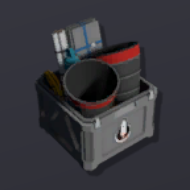Pumped Liquid Engine
From Unofficial Stationeers Wiki
 | |
| Fabrication | |
|---|---|
| Created with | Autolathe (Tier One) |
| Cost | 60000 Energy, 15g Steel, 5g Electrum, 10g Constantan |
| Temperature | |
| Flashpoint | 373K (100°C) |
| Autoignition | 573K (300°C) |
| Other properties | |
| Paintable | Yes |
| Stack Size | 1 |
| Prefabs | |
| Prefab Hash | 1921918951 |
| Prefab Name | ItemKitPumpedLiquidEngine |
 | |
| Operation | |
|---|---|
| Base Power Usage | 200W |
| Contruction | |
| Total cost | 2,5g Iron, 17g Steel, 5g Electrum, 10g Constantan |
| Constructed from | Kit (Pumped Liquid Engine) |
| Other properties | |
| Paintable | Yes |
| Prefabs | |
| Prefab Hash | -23091440019 |
| Prefab Name | StructurePumpedLiquidEngine |
Description
"Liquid propellants bring greater efficiencies with Pumped Liquid Engine. Two inputs are provided so Stationeers can seperate their fuels, the Setting variable controls the mixing ratio of the inputs. The engine is designed to run on Liquid Volatiles and Liquid Oxygen, some Stationeers have reported excessive thrust values by switching to Liquid Nitrous Oxide."
- Stationpedia
Comparison
Rocket Engines give you their max output in kN with this you can calculate what they can reasonably carry into orbit depending on the planet or moon you are on. Force = Mass * Acceleration. Acceleration is equal to the planet's gravity, Mass is given in kg per part of the rocket, and Force is kN. If your thrust force listed below is less than the weight of the rocket in kN then you will not even take off. It is better to have a thrust much higher than the weight of the rocket or else you risk running out of fuel on launch and on landing.
Liquid propellants bring greater efficiencies. Using Nitrous Oxide as oxidizer provides excessive thrust values. Keep in mind that N2O fuel mix is 1.9375 times heavier at same moles, or 2.15 times heavier at same volume, while thrust boost is around 1.5-1.7. Engine efficiency determines "bonus" thrust multiplier, meaning engine with higher efficiency will give more thrust consuming same amount of fuel. Thus using liquid engines is more favorable if one can cool fuel down, moreover Pressure Fed Engines consume fuel inversely proportional to its temperature. On the other hand if Volatiles and Oxygen are in excess (e.g. farm on Vulcan) is may be much easier to opt for Pressure Fed Gas Engine. It will provide ~40kN at 20°C.
| Name | Base Power Usage | Rocket Mass Contribution | Max Thrust | Real Max Thrust | Efficiency | Exhaust Velocity | |
|---|---|---|---|---|---|---|---|
| Using O2 | Using N2O | ||||||
| Pressure Fed Gas Engine | 10W | 500kg | 40,3kN | 61,0kN | 41,9kN[1] | 96% | 3,86km/s (Isp: 394s) |
| Pumped Gas Engine | 200W | 500kg | 16,2kN | 16,5kN | 24,5kN | 100% | 4,02km/s (Isp: 411s) |
| Pumped Liquid Engine | 200W | 500kg | 17,6kN | 18,7kN | 31,3kN | 140% | 5,47km/s (Isp: 559s) |
| Pressure Fed Liquid Engine | 20W | 500kg | 29,2kN | 43,4kN - 38,1kN | 74,5kN - 61,3kN | 160% | 6,18km/s (Isp: 631s) |
| Update 0.2.4726.21691 - 18/01/2024 Rocket_Engines | |||||||
- ↑ N2O must be much hotter to avoid condensing therefore decreasing pumping rate
